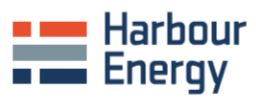Decommissioning
Reduction in UK emissions by 2030 targeted by Viking CCS
Safely plugged and abandoned in the Southern North Sea in 2022
Removed and recycled from Southern North Sea activities over a 10 year programme
Harbour seeks to responsibly decommission retired oil and gas infrastructure where it is not possible to repurpose it for use in CCS projects. Throughout 2023, our decommissioning team continued to deliver strong safety and environmental performance.
The deconstruction resulted in a 95% recycle and reuse rate of the 19,981 tonnes (gross) of vessel materials. Furthermore, we completed the dismantlement of the Murdoch platform and jacket structures. The campaign comprised of dismantling three separate structures and resulted in over a 99% recycling and reuse rate for 10,495 tonnes (gross) of materials. Additionally, the living quarters of the Murdoch platform will be refurbished and reused as the office and welfare space for use in a recycling yard.In the Southern North Sea and East Irish Sea, we successfully plugged and abandoned a number of wells, while in the Central North Sea we continued an extensive subsea campaign in the MacCulloch, Huntington and B-Block areas.
Through our vessel decommissioning activities, we successfully completed the dismantlement of the Balmoral Floating Production Vessel structure.
See below for further details of some of our decommissioning programmes/activities:
The Caledonia Field is a subsea development located in UKCS Block 16/26, which was tied back to the Britannia platform. The field came on stream in 2003.
CMS Area - operator (working interest ranges from 39.0% to 59.5%)
The CMS area consists of the Murdoch, Caister, Boulton, CMS III, Kelvin, Katy and Munro fields. Decommissioning work is ongoing and platform removals will continue through to 2024.
- Environmental Assessment for the Caister Murdoch System
- Comparative Assessment for Pipelines and Mattresses in the Caister-Murdoch System
- Decommissioning Programme for Caister CM Pipelines, CDP1b
- Decommissioning Programmes for the Caister Murdoch System III Installations and Pipelines, CDP2
- Decommissioning Programmes for Murdoch Installations and Trunk Pipelines, CDP3
LOGGS Area - operator (working interest ranges from 20.0% to 61.1%)
The LOGGS area consists of the North Valiant, South Valiant, Vanguard, Vulcan, Vampire, Viscount, Saturn, Mimas, Tethys and Jupiter fields. The LOGGS complex is now in cold suspension. Decommissioning work to plug and abandon remaining wells will continue through to 2022, with removal of the remaining LOGGS area platforms continuing through to 2024.
- LOGGS Installation & North Valiant PD - LOGGS PR, LOGGS PC, LOGGS PP, LOGGS PA, North Valiant PD & Associated Pipelines Decommissioning Programmes
- LOGGS Area Decommissioning - LOGGS LDP2-5 Comparative Assessment Report
- LOGGS Area Decommissioning - Environmental Appraisal to the LOGGS LDP2-LDP5 Decommissioning Programmes
- LOGGS Satellites Jupiter Area: Ganymede ZD topsides only (LDP3b) Decommissioning Programme
- LOGGS Satellites Jupiter Area: Ganymede ZD Jacket, Europa EZ, Callisto ZM and NW Bell ZX & Associated Infield Pipelines (LDP3) Decommissioning Programmes
- LOGGS Satellites, LDP2: Mimas MN, Saturn ND & Tethys TN & Associated Infield Pipelines Decommissioning Programmes
- LOGGS Satellites V-Fields Area, LDP4: Vanguard QD, North Valiant SP, South Valiant TD and Vulcan RD & Associated Infield Pipelines Decommissioning Programmes
Viking Area – operator Viking/Vixen 50.0%; Victor 20.0%
The Viking area consists of the Viking, Vixen and Victor fields. Production from Viking ceased in 2016 and decommissioning is nearing completion. Platform removals began in 2019. The final two subsea wells are scheduled to be plugged and abandoned in 2021-2022.
Theddlethorpe Gas Terminal (TGT) - operator 50.0%
The TGT site in Lincolnshire was deemed hydrocarbon-free in December 2019 and is now in cold suspension. Demolition started in 2020 and is expected to take 18 months to complete. Land remediation and restoration will follow through to 2023.
MacCulloch - operator 40.0%
MacCulloch in Block 15/24 of the CNS ceased production in 2015. Removal of the remaining subsea infrastructure is due to take place between 2022 and 2024.
Huntington - operator 100.0%
First oil was achieved from Huntington in Block 22/14b of the CNS in April 2013. Cessation of production was originally planned for 2017, but production finally ceased in April 2020.
Huntington Decommissioning Programme for FPSO Float-off
Huntington Field Decommissioning Programme
Balmoral Area - operator (working interest ranges from 44.2% to 100.0%)
The Balmoral, Glamis, Stirling, Brenda and Nicol fields are in Blocks 16/21a, 16/21b and 16/21c of the UK CNS. The Balmoral area ceased production in October 2020.
Balmoral Decommissioning Programmes
Brenda Decommissioning Programmes
Nicol Decommissioning Programmes
Glamis Decommissioning Programmes
Stirling Decommissioning Programmes
Hunter and Rita - operator 79.0% and 76.0%
Cessation of production from Hunter and Rita was approved in January 2019. Hunter is in Block 44/23a of the SNS. The field was discovered in 1992 and developed in 2005. Rita in Blocks 44/21b and 44/21c was discovered in 1996 and developed in 2008 tied back to Hunter.
Johnston Field - operator (working interest 28.75%)
The Johnston Field is a subsea tieback to the Ravenspurn North Central Processing Platform, located in Blocks 43/26a and 43/27a in the southern North Sea. The field came on stream in 1994.
The East Irish Sea (EIS) portfolio consists of the Millom, Dalton and Calder fields. Production from the Dalton and Millom fields ceased in 2019 and 2020, respectively, and decommissioning is in progress. Production from the Calder field is expected to continue through to later this decade.
The Solan Field, which came on stream in 2016, is located in block 205/26a of the Northern North Sea, approximately 135 kilometres West of Shetland. Following cessation of production, the facilities will be flushed, cleaned and disconnected, ready for decommissioning activities to commence.
